May 2002 lunar eclipse
A penumbral lunar eclipse took place on May 26, 2002, the first of three lunar eclipses in 2002.
| Penumbral eclipse | |||||||||
| Date | 26 May 2002 | ||||||||
|---|---|---|---|---|---|---|---|---|---|
| Gamma | 1.17591 | ||||||||
| Magnitude | 0.68933 | ||||||||
| Saros cycle | 111 (66 of 71) | ||||||||
| Penumbral | 216 minutes, 38 seconds | ||||||||
| |||||||||
Visibility
The beginning of the penumbral phase visible in most of North America except the northeast, Central America, western South America, extreme northeast Russia, eastern Asia, Australia, most of Antarctica, the Pacific Ocean, and the southeast Indian Ocean; the end visible in southwestern Alaska, Asia except the extreme north, Australia, the eastern Indian Ocean, and most of the Pacific Ocean except the extreme eastern part.
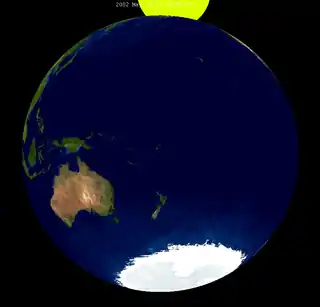
Relation to other lunar eclipses
Eclipses of 2002
- A penumbral lunar eclipse on May 26.
- An annular solar eclipse on June 10.
- A penumbral lunar eclipse on June 24.
- A penumbral lunar eclipse on November 20.
- A total solar eclipse on December 4.
It is the first of four lunar year cycles, repeating every 354 days.
| Lunar eclipse series sets from 2002–2005 | ||||||||
|---|---|---|---|---|---|---|---|---|
| Descending node | Ascending node | |||||||
| Saros Photo |
Date View |
Type Chart |
Gamma | Saros Photo |
Date View |
Type Chart |
Gamma | |
| 111 | 2002 May 26 |
penumbral |
1.1759 | 116 | 2002 Nov 20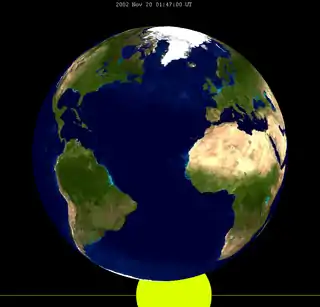 |
penumbral |
-1.1127 | |
121 |
2003 May 16 |
total |
0.4123 | 126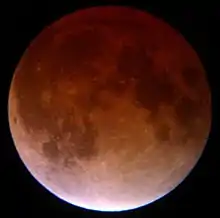 |
2003 Nov 09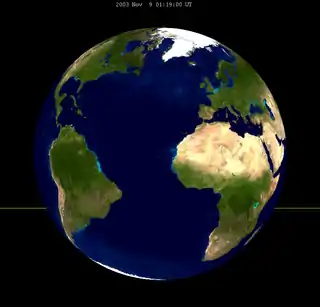 |
total |
-0.4319 | |
131 |
2004 May 04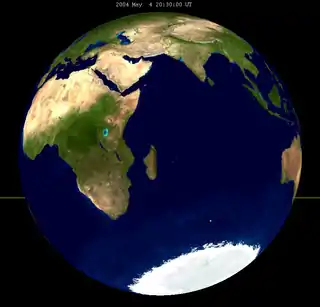 |
total |
-0.3132 | 136 |
2004 Oct 28 |
total |
0.2846 | |
| 141 | 2005 Apr 24 |
penumbral |
-1.0885 | 146_(cropped).jpg.webp) |
2005 Oct 17 |
partial |
0.9796 | |
| Last set | 2002 Jun 24 | Last set | 2001 Dec 30 | |||||
| Next set | 2006 Mar 14 | Next set | 2006 Sep 7 | |||||
Saros series
Lunar Saros 111, repeating every 18 years and 11 days, has a total of 71 lunar eclipse events including 11 total lunar eclipses. The first total lunar eclipse of this series was on April 19, 1353, and last was on August 4, 1533. The longest occurrence of this series was on June 12, 1443 when the totality lasted 106 minutes.
Half-Saros cycle
A lunar eclipse will be preceded and followed by solar eclipses by 9 years and 5.5 days (a half saros).[1] This lunar eclipse is related to two partial solar eclipses of Solar Saros 118.
| May 21, 1993 | June 1, 2011 |
|---|---|
 |
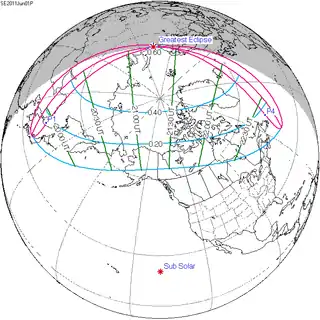 |
See also
- List of lunar eclipses
- List of 21st-century lunar eclipses
References
- Mathematical Astronomy Morsels, Jean Meeus, p.110, Chapter 18, The half-saros
External links
- Saros cycle 111
- 2002 May 26 chart: Eclipse Predictions by Fred Espenak, NASA/GSFC
- http://www.eclipse.org.uk/eclipse/1132002/

